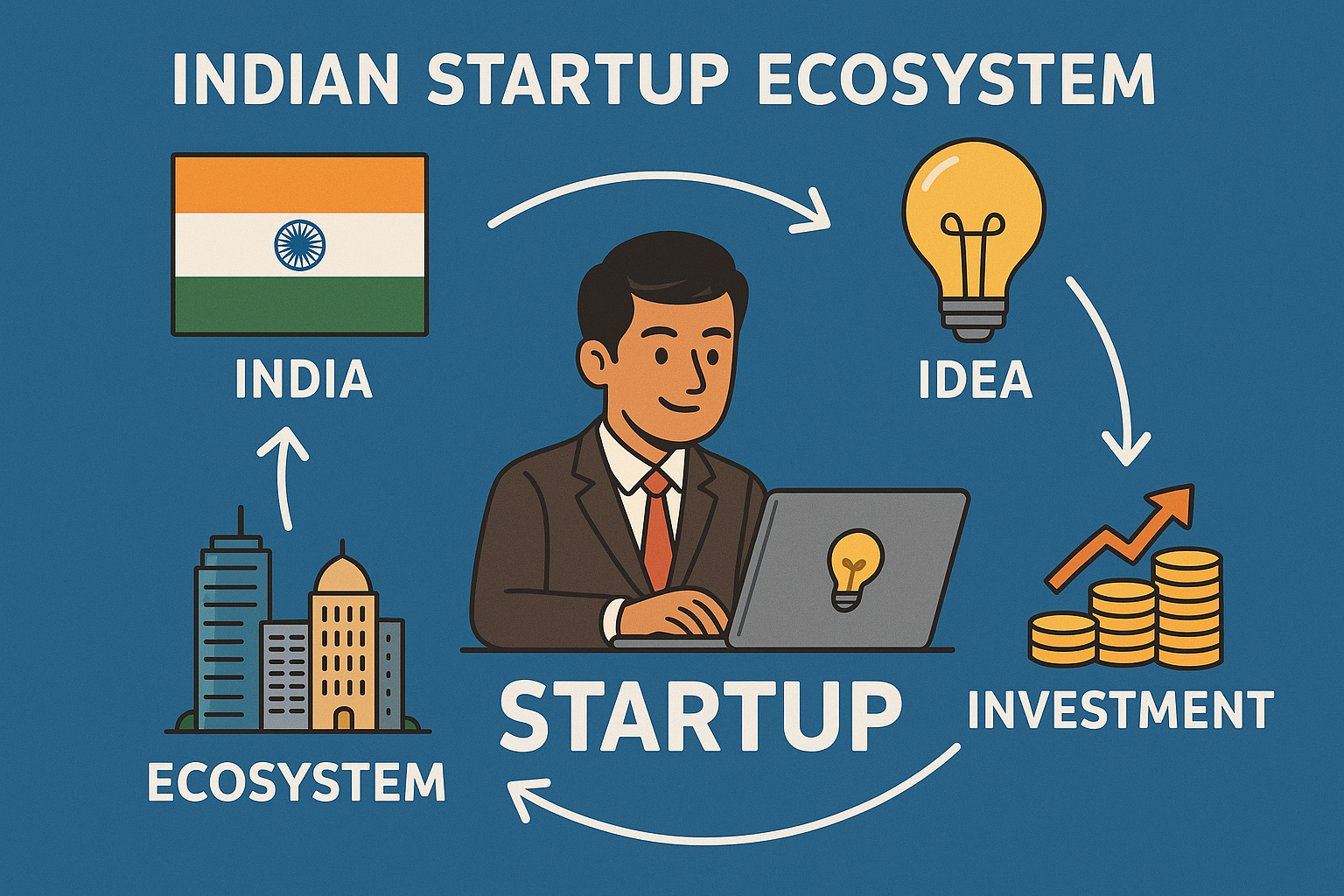India’s Startup Pulse: Jobs Galore, Funding Shifts, and the Quest for Capital
India’s startup ecosystem is a dynamic paradox. On one hand, it’s a vibrant powerhouse of job creation, continually churning out opportunities for millions. On the other, it’s navigating a tighter funding landscape, demanding more from its innovative ventures. If you’re an aspiring entrepreneur, understanding these currents, and especially how to fuel your dream, is crucial.
The Unstoppable Job Engine
Let’s start with the good news that often gets overshadowed: Indian startups are a formidable force in employment. With over 1.14 lakh (114,000) recognized startups, they have collectively generated an impressive over 12 lakh (1.2 million) jobs. This isn’t just a number; it’s a testament to the entrepreneurial spirit thriving across the nation, absorbing talent and fostering innovation in diverse sectors.
A Funding Reality Check: The 2025 Story So Far
Despite the robust job growth, the Indian tech startup funding scene has experienced a noticeable shift. In the first half of 2025, funding witnessed a 25% year-on-year decline, dropping to $4.8 billion from $6.4 billion in the same period of 2024. While this might sound concerning, it’s essential to put it in perspective:
- Global Standing: India still holds its ground as the third largest tech startup ecosystem globally in terms of funding, behind only the US and the UK. This indicates continued international confidence in India’s long-term potential.
- Maturity and Prudence: This slowdown is largely seen as a market correction, pushing startups to focus more on sustainable growth, strong unit economics, and profitability rather than just rapid expansion at any cost. Investors are now more discerning, prioritizing robust business models over mere hype.
- Sectoral Shifts: While overall funding is down, specific sectors like transportation & logistics tech (especially EV and mobility-as-a-service), SaaS (Software-as-a-Service), and Fintech continue to attract significant investment. There’s also a strong focus on AI-driven solutions, though the debate continues on whether investments are backing genuine deep-tech innovation or just riding the AI wave.
What Exactly is a “Startup,” Anyway?
Before we dive into funding, let’s clarify what we mean by “startup.” While every startup is a new business, not every new business is a startup.
A startup is typically defined by:
- Innovation: It introduces a novel product, service, or a significantly improved way of doing something.
- Scalability: It’s designed for rapid, widespread growth, often leveraging technology to reach a large, even global, market quickly.
- Uncertainty & Risk: It operates in high-risk environments, aiming to disrupt existing markets or create entirely new ones.
- External Investment Focus: Due to initial high costs and a focus on growth over immediate profit, startups often seek venture capital, angel investments, or seed funding.
In contrast, a traditional business might be a local shop, a consultancy, or a restaurant. It focuses on stable, steady growth, often serving a local market, and prioritizes immediate profitability and predictable returns. While equally valuable to the economy, its growth trajectory and funding needs differ significantly from a high-growth startup.
The Big Hurdle: Getting Loans Without Business History
This brings us to a common pain point for new entrepreneurs: securing a loan from private banks when you have no prior business details or a 1-2 year operational history. You’re absolutely right; this is a major challenge. Traditional lenders are inherently risk-averse and typically require:
- Proof of Concept & Revenue: Detailed financial statements (P&L, Balance Sheet), consistent ITRs, and bank statements that demonstrate a track record of income generation and repayment capacity.
- Collateral: Tangible assets like property, machinery, or inventory to secure the loan.
- Credit History: A solid personal and business credit score, indicating financial discipline.
For a nascent startup or a new small business, these requirements are almost impossible to meet. This is why many promising ideas get stuck in the initial phase.
Navigating the Funding Maze: Solutions for Aspiring Entrepreneurs
The good news is that both the Indian government and a growing ecosystem of alternative funders are stepping up to bridge this gap:
1. Government Schemes: Your First Port of Call
India has several progressive schemes designed to support new and small businesses, often with relaxed collateral requirements:
Pradhan Mantri Mudra Yojana (PMMY): Offers collateral-free loans up to INR 10 lakh (and up to 20 lakh under “Tarun+”) for micro and small enterprises across manufacturing, trading, and services. Loans are categorized as Shishu (up to ₹50,000), Kishore (₹50,001 to ₹5 lakh), and Tarun (₹5 lakh to ₹10 lakh). The focus is on project viability.
Stand-Up India Scheme: Aims to promote entrepreneurship among women and Scheduled Castes/Tribes, providing loans from INR 10 lakh to INR 1 crore for greenfield (first-time) projects.
Credit Guarantee Scheme for Micro and Small Enterprises (CGTMSE): This scheme provides a credit guarantee cover to banks, encouraging them to offer collateral-free loans to eligible MSMEs, often up to INR 2 crore.
Startup India Seed Fund Scheme (SISFS): For very early-stage startups, this scheme provides financial assistance through approved incubators. It offers grants (up to INR 20 lakh) for proof of concept and prototype development, and convertible debentures/debt (up to INR 50 lakh) for market entry.
GENESIS (Gen-Next Support for Innovative Startups): A MeitY initiative to boost the startup ecosystem, particularly in Tier-II and Tier-III cities, offering various support including pilot funding and investment support for tech startups.
Where to Apply for Government Schemes: You can often apply through commercial banks, small finance banks, or dedicated government portals like Udyamimitra (jansamarth.in) and the Startup India portal.
Alternative Funding Avenues:
Beyond traditional banks and specific government schemes, consider these options:
Self-Funding/Bootstrapping: Using your personal savings or funds from family and friends is often the initial capital source. It demonstrates commitment to potential future investors.
Angel Investors: High-net-worth individuals who invest their own money in early-stage startups, often providing invaluable mentorship alongside capital in exchange for equity.
Venture Capital (VC) Funds: These professional firms invest in high-growth potential startups for equity, typically at later stages (Seed, Series A, B, etc.) once a business model is somewhat validated.
Incubators and Accelerators: These programs provide not just mentorship, resources, and office space, but often crucial initial seed funding. They help startups refine their business models and prepare for larger investment rounds.
Crowdfunding: Raising small amounts of capital from a large number of individuals, usually via online platforms.
Focus on Your Business Plan and Personal Financials:
Even when applying for smaller or government-backed loans, a detailed and compelling business plan is paramount. It must clearly articulate your problem-solving approach, market analysis, revenue model, and realistic financial projections. Additionally, maintaining a strong personal credit score (CIBIL score) is vital, as it reflects your financial discipline and trustworthiness.
The Evolving Landscape
The Indian startup ecosystem is in a phase of evolution. While funding might be more selective, the emphasis on sustainable business models, profitability, and impactful innovation is ultimately building a stronger, more resilient foundation. For aspiring entrepreneurs, the journey is challenging but not without support. By understanding the distinct nature of a startup and leveraging the diverse funding avenues available, the dream of building a successful venture in India remains vibrant and achievable.

